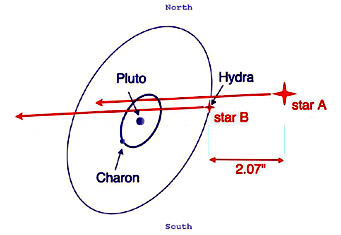At about 4.7h Universal Time on May 12, 2007, Pluto will
occult the 13.3-magnitude star UCAC2 25822467 in a path passing over
much of Antarctica and Patagonia. But in addition, Walker Vaning
believes that rings of very small particles will also occult the star
for observers in the whole hemisphere of Earth facing Pluto, which
includes all of South and Central America, most of the Atlantic Ocean
(including the Canary Islands), the Caribbean Sea, eastern Mexico,
eastern USA, and eastern Canada. The star is at right ascension
17h 53m 32.0s, declination
–16° 22' 47" (equinox 2000.0).
Vaning thinks that occultations by the rings could occur even a few
hours from the time of Pluto's closest approach to the star, so that
observers in western Europe and southern Africa might try to record
before sunrise, and those in western North America have a chance as
soon as Pluto rises high enough for effective observation. Since the
particles are small, there is a substantial wavelength dependence on
the visibility; Vaning recommends observing in the blue, at as short a
wavelength as possible. Vaning claims that he finds as many as 30
rings in the Kuiper Airborne Observatory blue observations of the 1988
occultation, but that the ring occultations are very shallow or absent
in visual and red wavelengths.

The star involved with Pluto on May 11-12 is actually double, and Pluto's outer moon, Hydra, could occult the B component. This plot applies to the event as seen from the Gibraltar area.
Jean Lecacheux
LATE UPDATE: It turns out that the star to be occulted by the
Pluto system tonight is binary. The main star (A) is a bit
brighter than Pluto and the companion star (B) is perhaps a little fainter
than Pluto. The B star is expected to be occulted by Hydra, the small outer
satellite of Pluto, within a few minutes of 3:14 UT May 12th. More details
are given by Bruno Sicardy here. Jean Lecacheux in France writes,
"The duration in case of a central event could be between 2 and 7 seconds.
The nominal path of the Hydra shadow is predicted above northern Africa,
Gibraltar, and the Azores, but taking into account the large uncertainty
and the morning twilight, the event has to be monitored southside from
the Canaries, and northside from continental Spain and Portugal, the
Baleares and south of France. This will be a very difficult observation, as
the faint occulted star will be jammed between two brighter bodies, the main
star A to the west and Pluto slowly approaching (at 2.85" per hour) from the
east."
Pluto Occultations on July 31st and September 27th
David Herald predicts two more occultations of reasonably bright stars
this year. On July 31, 2007, around 13.8h UT, Pluto occults
13.3-magnitude UCAC2 25815762 at right ascension 17h
45m 42.0s, declination –16° 29' 32".
This event should be visible from much of Antarctica and probably New
Zealand (the latter especially considering the north shift from
Pluto's ephemeris that may have caused the north shift during the
March occultation). During this event ring occultations are possible
as seen from Australia, Indonesia, Philippines, Japan, Asia, and
eastern Africa.
Then on September 27, 2007, around 14.8h UT, Pluto passes
extremely close to an 8.7-magnitude (!) star, SAO 160793. Earth will
actually pass "between the shadows" of Pluto and Charon, with no
occultation by either object visible from Earth's surface. But
occultations by possible Plutonian rings might be observed from the
night areas of most of Asia (from Arabia to Vietnam to western and
southern China to the Ural Mountains), the Horn of Africa, western
Australia, part of Antarctica, and the Indian Ocean. The star's UCAC2
position is 17h 44m 38.4s,
–16° 46' 35".
Note that these observations will be beyond the range of most
amateurs; they involve obtaining continuous photometric tracings of
the combined light of Pluto and the star that can be analyzed later
for weak fluctuations due to rings.
Independent predictions and some graphics for these occultations,
based on astrometric observations at Lowell Observatory, can be found
at this MIT website. It also lists one more event (May 14th), but in that case the star is too faint for the confirmation of
Plutonian rings.
Reporting Your Observations
For occultations of stars by small solar-system bodies, we have
special report forms (.xls versions preferred, but plain-text forms
are available as well) at these URLs:
Once you complete one of these forms, please send it to IOTA's e-mail
address reports@asteroidoccultat
ion.com, which is also used for reporting asteroid-occultation observations.
Additional resources for reporting your observations are available at
the website of the North American Asteroid Occultation Program:
Please check the online version of this AstroAlert on Sky &
Telescope's website for possible minor updates:
Any major updates will be announced via subsequent AstroAlert
messages. Good luck, and clear skies!
 0
0









Comments
You must be logged in to post a comment.